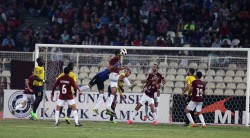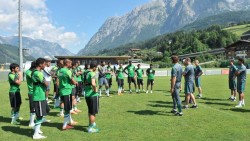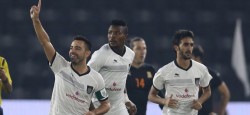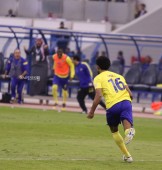-
 Ahdaaf 2018 Predictions
1 month ago
Ahdaaf 2018 Predictions
1 month ago -
 Ali Kadhim: The Iraqi goalscoring legend
1 week ago
Ali Kadhim: The Iraqi goalscoring legend
1 week ago -
 Reds in the Sand: Three Liverpool Men Who Played in UAE
4 weeks ago
Reds in the Sand: Three Liverpool Men Who Played in UAE
4 weeks ago -
 Qatar Aspires to Global Dominance through European Network
4 weeks ago
Qatar Aspires to Global Dominance through European Network
4 weeks ago
TACTICS: New look Lebanon under Radulovic
Lebanon have come over leaps and bounds under Montenegrin Miodrag Radulovic. Although they have all but failed to qualify to the final stage of the World Cup Qualifiers, the fan base has suddenly turned optimistic in the Cedars’ bid to enter the revamped structure of the Asian Cup in the U.A.E in 2019.

Lebanon’s Montenegrin manager Miodrag Radulovic reacts during their 2018 World Cup qualifying group G football match against Kuwait in the southern Lebanese city of Sidon on June 11, 2015. AFP PHOTO / STR
Lebanon are steadily rising under Radulovic and haven’t looked as tactically smart since Theo Bucker’s two year stint. What was missing from this side to help them challenge for the top spots? A better finisher up front coupled up with possibly more movement from Moni to free Maatouk, the star of the Lebanese National Team.
Instead of dissecting Lebanon’s tactical features in detail, I will look at what they have excelled at (tactically) under Radulovic. For all the character that Bucker had, Radulovic compensates for that with his tactical intelligence.
Individual issues
Lebanon have only conceded 4 goals in the World Cup Qualifiers, and when you look at the goals they don’t come from tactical problems rather individual problems. Let’s address them here first.
Goalkeeping Dilemma – Abbas Hassan has been a controversial pick for Lebanon. Despite Lebanon’s success under Bucker, he was always the weak link. Therefore, Radulovic came under scrutiny after picking Hassan after his consistent blunders. Mahdi Khalil is currently the best goalkeeper in Lebanon at Safa SC yet the sole fact that Abbas Hassan plays for Elfsborg in Sweden (where he has played 3 games in the space of 2 years) saw him ‘earn’ a first team spot.
Mahdi Khalil entered the fray against Myanmar and Kuwait after Hassan’s disastrous run of form, and Lebanon successfully nullified any defensive frailties via Khalil’s commanding performances in goal. “What if?” Lebanese fans ask. “What if Khalil played against Kuwait in the first game, and helped us at least hold them to a 0-0 draw? We’d have much more of a chance to qualify.”
Abbas Hassan’s passiveness has proved a big problem for Lebanon. In 3 of the goals he conceded (1 has been as a result of a penalty) we can see how he either a) stares at the ball going in, without any attempt at moving or b) making a late dive to save the ball, which he ultimately fails in. The arrival of Khalil has strengthened the Lebanese defence massively.
Khalil’s confidence, command of area and communication has become the epitome of Lebanese goalkeeping since the retirements of Ziad Al-Samad and Larry Mehanna.
Individual defensive ability – Legendary centre back Youssef ‘Dodo’ Mohammad has been away from club football for more than 1 and a half years and is still going strong. You can’t blame him for the little, if any, mistakes he makes. Yet his commanding performance has been lauded in the media and rightly so.
The only significant problem – which is now offset by Lebanon’s medium to low defensive block – is his partner. Although Joan Oumari and Bilal Najjarine aare good players, they struggled to fit in. The reason for this derives from their tendency to draw themselves towards the attacker Dodo is taking care of. However that could be linked to Lebanon’s attacking intentions towards the end of the game against Kuwait (away from home). Moreover, South Korea possess players in the English Premier League such as Ki, and were no doubt many levels above the in-transition Lebanon.
Finishing Dilemma – 75% of the goals Lebanon have scored in the World Cup Qualifiers have occurred due to Hassan Maatouk’s involvement. The only goal scored without his touches or movement was Abbas Atwi’s goal against a relatively weak Myanmar (who shipped 9 goals against Kuwait) in injury time.
Despite the addition of tricky and former Al-Ittihad Jeddah winger Mohammad Haidar, Lebanon have failed to put the ball in the net more than four times in five games; a travesty in itself.
Mohammad Ghaddar and Moni haven’t played club football in more than 6 months (the latter for much longer), Philippe Paoli is still a part of the U-23 team and former Sporting KC forward Soony Saad – sadly – has missed out a large portion of playing time due to injury.
Defensive structure
Block and set-up
Radulovic has indoctrinated a 4-5-1 medium-low defensive block system that ensures the protection of the most important part of the pitch: the centre. With Lebanon boasting two powerful 1-on-1 full backs in Ali Hamam and Walid Ismail (defensively), both of whom are able to recycle possession well, Radulovic needn’t to worry about the flanks as opposed to the heart of the pitch.

This match saw two ‘strikers’ up front for Lebanon. Abbas Atwi and Roda Antar played as False 10’s to block the SK defensive midfielders from receiving the ball. Tactical flexibility.
Defensive midfielders
The Lebanese strength in the centre comes from the defensive midfielders. Another variation that Radulovic has used was adding a centre back into defensive midfield to win aerial battles and add a body in midfield to support Haitham Faour. Joan Oumari (FSV Frankfurt) and Nour Mansour (Safa SC) have been tried in defensive midfield, and both have performed well.
These have not only added ‘aerial’ winners, but in Mansour and Oumari you have different players. Oumari was played alongside the calmer Haitham Faour against SK, to bring an aggressive style of play to the proceedings. On the other hand, Mansour dropped behind Antar against Kuwait in the absence of Faour to cover the space around him and block any chances stemming from the talented Saif Al-Hashan.

Mansour (circled) in between a triangle of Kuwaiti players, positions himself well – to defend, not receive the ball – in case of any turnovers.
Pressing
Lebanon are extremely passive in the press, with their high-pressure deliberately a form of delay rather than win the ball back.

In this image we can see how Lebanon position themselves far away from Kuwait’s defenders to organise themselves.
However, it was clear that Radulovic highlighted Fahad Al-Ansari of Kuwait. He stands at 1.95m tall, with long legs helping him to intercept the ball easily. Plus, he is adept at playing the ball out of defence.
To battle this, Radulovic blocked the centre under all circumstances. Knowing that the full backs are adept at 1-on-1 situations defensively, he was assured of security in deeper areas.

This picture shows all of the tactical ideas put into place. Al-Ansari is not being heavily pressed, but “delayed” until Lebanon tire Kuwait into winning the ball. We see Nour Mansour near Al-Hashan in the middle although not man-marking him, while Oumari’s aggressive tendency sees him move out of the defensive line and screaming instructions.

One of the best Arabian football players, Bader Al-Mutawa (#17) drops all the way back to defensive midfield to help Kuwait! Note, Al-Mutawa is a “False 10” (attacking midfielder who acts as a striker) and instead he had to drop deeper.
Attacking structure
The key problem for Lebanon across the course of the qualifiers has been their attacking profligacy. Besides scoring 4 in respective 2-2 draws against Iraq and Syria, they have only seen 4 goals scored (combined) against Palestine, Jordan, South Korea, Kuwait, Myanmar and Laos.
Kuwait alone against Myanmar scored more goals in the second half against Myanmar than Lebanon did in the whole qualifying process. A more worrying stat comes in the form of 2015 itself, where Kuwait scored more goals (9) against Myanmar than Lebanon did in the whole of 2015 (8).
Let’s look at how Lebanon’s structure has adapted under Radulovic. One very key tactical aspect used by Pep Guardiola and Thomas Tuchel is overloading one side of the field. They do this to free up space on the “underloaded side on the pitch”. This is where they let Arjen Robben or Henrikh Mkhitaryan attack space with much more space around them. In this case, the “Arjen Robben” is the dazzling Hassan Maatouk who plays for Fujairah SC in the United Arab Emirates.
The Lebanese players have adapted to each other and the system very well – considering they did not play together for more than a year, before the arrival of Radulovic – and it can see Walid Ismail (LB) or Mohammad Haidar (RW) do the same and be found in space to receive the ball and counter attack into space.
The reason that Lebanon failed to execute this could go down to the fact that this was the first time it was implemented to its optimum potential (relative to Lebanon and Middle Eastern football level) and still had the final parts of finishing (which is a psychological and talent-centric aspect of football) which didn’t work. Hassan Maatouk is not Ronaldo, and even Ronaldo isn’t a factor for his team every single game.
Conclusion
Calls for Radulovic to depart have started to lessen. Many people are still optimistic for a final push with Radulovic for the final round of qualifiers but know that it may be inevitable should the nation not qualify.
In an era where tactics and statistics triumph over sole talent, Radulovic is using his time well to scout and plan for the Lebanese national team. After all, he travelled around Europe all summer looking for players of Lebanese origin.
It’s time for Lebanon to understand that there is a way out without talented players and that is strategic triumph on the pitch. With that, current players will develop under the reign of the current manager.
- Fabio Lopez and his “miracle” job at Al-Ahli (KSA) - April 5, 2017
- 2017 AFC CHAMPIONS LEAGUE PREVIEW: WEST ASIA - February 19, 2017
- تحليل تكتيكي : الوصل 2-1 الوحد - February 3, 2017
- PREVIEW: 2016 ASIAN CHAMPIONS LEAGUE FINAL - November 18, 2016
- Saudi Football’s Liberation Must Wait - September 7, 2016
- WCQ2018 Asia: 6 Talking Points from the Middle East - September 7, 2016
- PRESS TALK: August 31, 2016 - August 31, 2016
- FRIDAY WITH… FABIO LOPEZ - August 26, 2016
- PRESS TALK: AUGUST 25, 2016 - August 25, 2016
- PREVIEW: AL-AIN VS. LOKOMOTIV | #ACL2016 - August 22, 2016
Similar posts
-
 Domestic Leagues
Domestic Leagues
Nejmeh vs. Ahed: Preview
-
 International SquadsInternationals
International SquadsInternationals
#WCQ2018: SAUDI NATIONAL TEAM SQUAD (September ’16)
-
 Featured
Featured
The Birth, Death and Re-Birth of Lebanese Football
-
 Top 5 Goals of the Week
Top 5 Goals of the Week
TOP 5 GOALS OF THE WEEK: SEASON 1, EPISODE 1
-
 PodcastUncategorized
PodcastUncategorized
2015 REVIEW PODCAST
-
 Iraqi Premier LeaguePersian Gulf Pro LeagueQatar Stars LeagueSaudi ALJ League
Iraqi Premier LeaguePersian Gulf Pro LeagueQatar Stars LeagueSaudi ALJ League
Talking Points: Around the Middle East (December 10-15)
-
Ali Naffaa














